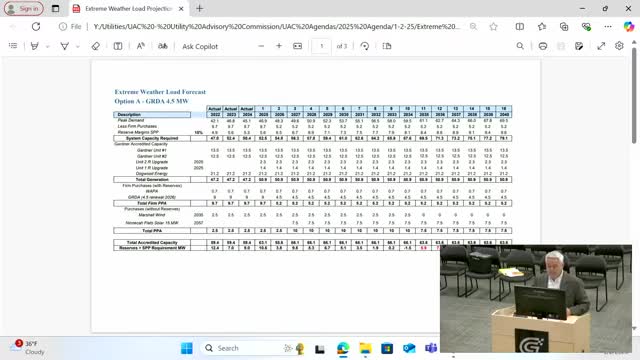City Council debates $5M annual payment for reliable energy capacity
January 02, 2025 | Gardner City, Johnson County, Kansas
This article was created by AI summarizing key points discussed. AI makes mistakes, so for full details and context, please refer to the video of the full meeting. Please report any errors so we can fix them. Report an error »

In the heart of Gardner City Hall, a pivotal discussion unfolded during the recent City Council meeting, where officials grappled with the pressing question of energy reliability versus cost. As council members gathered under the bright lights, the atmosphere was charged with the weight of decisions that could impact the community for years to come.
The focal point of the meeting was a proposal regarding energy capacity, specifically the choice between two options: a lower capacity at a reduced cost or a higher capacity that promises greater reliability. One council member raised a critical point, emphasizing the potential risks associated with opting for the lower capacity. “We can go as low as size 4.5,” they noted, “but that comes with uncertainties, especially considering the unpredictable nature of weather patterns.”
The discussion quickly turned to the financial implications of these choices. The council was faced with a stark decision: should they invest an additional $5 million over five years for a more reliable energy source? This question resonated deeply, as it not only reflected the city’s immediate energy needs but also its long-term sustainability goals. “We’ve paid $5 million more in the past for reliable energy,” another member pointed out, highlighting the historical context of their energy expenditures.
As the debate continued, the council weighed the benefits of guaranteed capacity against the financial burden it would impose on the city’s budget. The tension in the room was palpable, with members considering the balance between fiscal responsibility and the necessity of dependable energy for the community.
Ultimately, the meeting underscored a crucial moment for Gardner—a decision that could shape the city’s energy landscape and financial health for years to come. As the council deliberates, residents are left to ponder the implications of their choices, hoping for a future where energy is both reliable and affordable.
The focal point of the meeting was a proposal regarding energy capacity, specifically the choice between two options: a lower capacity at a reduced cost or a higher capacity that promises greater reliability. One council member raised a critical point, emphasizing the potential risks associated with opting for the lower capacity. “We can go as low as size 4.5,” they noted, “but that comes with uncertainties, especially considering the unpredictable nature of weather patterns.”
The discussion quickly turned to the financial implications of these choices. The council was faced with a stark decision: should they invest an additional $5 million over five years for a more reliable energy source? This question resonated deeply, as it not only reflected the city’s immediate energy needs but also its long-term sustainability goals. “We’ve paid $5 million more in the past for reliable energy,” another member pointed out, highlighting the historical context of their energy expenditures.
As the debate continued, the council weighed the benefits of guaranteed capacity against the financial burden it would impose on the city’s budget. The tension in the room was palpable, with members considering the balance between fiscal responsibility and the necessity of dependable energy for the community.
Ultimately, the meeting underscored a crucial moment for Gardner—a decision that could shape the city’s energy landscape and financial health for years to come. As the council deliberates, residents are left to ponder the implications of their choices, hoping for a future where energy is both reliable and affordable.
View full meeting
This article is based on a recent meeting—watch the full video and explore the complete transcript for deeper insights into the discussion.
View full meeting
